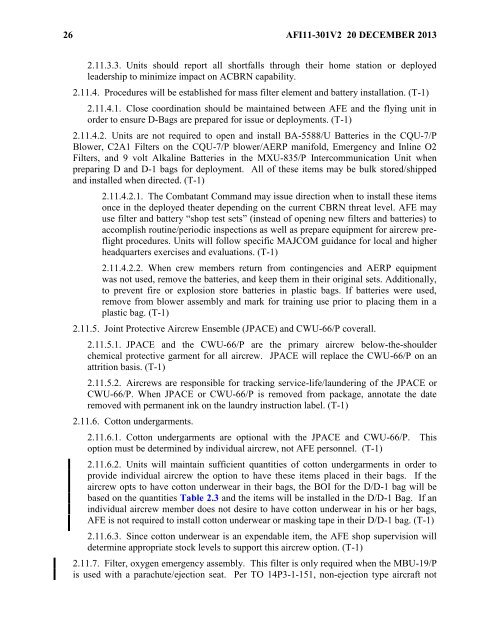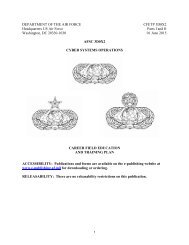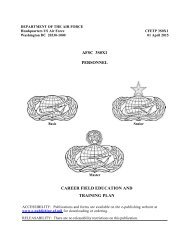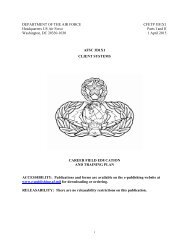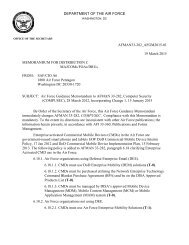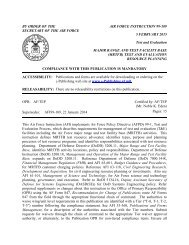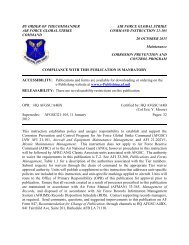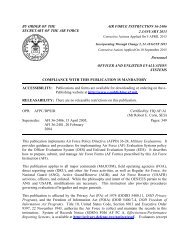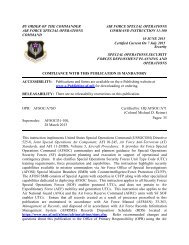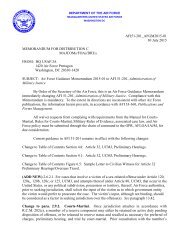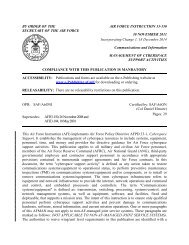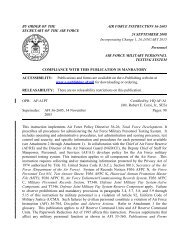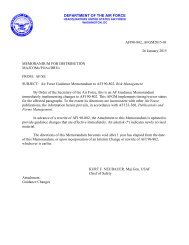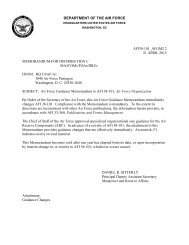COMPLIANCE WITH THIS - Air Force Link
COMPLIANCE WITH THIS - Air Force Link
COMPLIANCE WITH THIS - Air Force Link
You also want an ePaper? Increase the reach of your titles
YUMPU automatically turns print PDFs into web optimized ePapers that Google loves.
26 AFI11-301V2 20 DECEMBER 2013<br />
2.11.3.3. Units should report all shortfalls through their home station or deployed<br />
leadership to minimize impact on ACBRN capability.<br />
2.11.4. Procedures will be established for mass filter element and battery installation. (T-1)<br />
2.11.4.1. Close coordination should be maintained between AFE and the flying unit in<br />
order to ensure D-Bags are prepared for issue or deployments. (T-1)<br />
2.11.4.2. Units are not required to open and install BA-5588/U Batteries in the CQU-7/P<br />
Blower, C2A1 Filters on the CQU-7/P blower/AERP manifold, Emergency and Inline O2<br />
Filters, and 9 volt Alkaline Batteries in the MXU-835/P Intercommunication Unit when<br />
preparing D and D-1 bags for deployment. All of these items may be bulk stored/shipped<br />
and installed when directed. (T-1)<br />
2.11.4.2.1. The Combatant Command may issue direction when to install these items<br />
once in the deployed theater depending on the current CBRN threat level. AFE may<br />
use filter and battery “shop test sets” (instead of opening new filters and batteries) to<br />
accomplish routine/periodic inspections as well as prepare equipment for aircrew preflight<br />
procedures. Units will follow specific MAJCOM guidance for local and higher<br />
headquarters exercises and evaluations. (T-1)<br />
2.11.4.2.2. When crew members return from contingencies and AERP equipment<br />
was not used, remove the batteries, and keep them in their original sets. Additionally,<br />
to prevent fire or explosion store batteries in plastic bags. If batteries were used,<br />
remove from blower assembly and mark for training use prior to placing them in a<br />
plastic bag. (T-1)<br />
2.11.5. Joint Protective <strong>Air</strong>crew Ensemble (JPACE) and CWU-66/P coverall.<br />
2.11.5.1. JPACE and the CWU-66/P are the primary aircrew below-the-shoulder<br />
chemical protective garment for all aircrew. JPACE will replace the CWU-66/P on an<br />
attrition basis. (T-1)<br />
2.11.5.2. <strong>Air</strong>crews are responsible for tracking service-life/laundering of the JPACE or<br />
CWU-66/P. When JPACE or CWU-66/P is removed from package, annotate the date<br />
removed with permanent ink on the laundry instruction label. (T-1)<br />
2.11.6. Cotton undergarments.<br />
2.11.6.1. Cotton undergarments are optional with the JPACE and CWU-66/P. This<br />
option must be determined by individual aircrew, not AFE personnel. (T-1)<br />
2.11.6.2. Units will maintain sufficient quantities of cotton undergarments in order to<br />
provide individual aircrew the option to have these items placed in their bags. If the<br />
aircrew opts to have cotton underwear in their bags, the BOI for the D/D-1 bag will be<br />
based on the quantities Table 2.3 and the items will be installed in the D/D-1 Bag. If an<br />
individual aircrew member does not desire to have cotton underwear in his or her bags,<br />
AFE is not required to install cotton underwear or masking tape in their D/D-1 bag. (T-1)<br />
2.11.6.3. Since cotton underwear is an expendable item, the AFE shop supervision will<br />
determine appropriate stock levels to support this aircrew option. (T-1)<br />
2.11.7. Filter, oxygen emergency assembly. This filter is only required when the MBU-19/P<br />
is used with a parachute/ejection seat. Per TO 14P3-1-151, non-ejection type aircraft not


